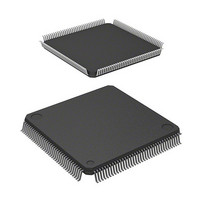R5F61665N50FPV Renesas Electronics America, R5F61665N50FPV Datasheet - Page 103

R5F61665N50FPV
Manufacturer Part Number
R5F61665N50FPV
Description
MCU FLASH 512K ROM 144-LQFP
Manufacturer
Renesas Electronics America
Series
H8® H8SX/1600r
Datasheet
1.R5F61665N50FPV.pdf
(1492 pages)
Specifications of R5F61665N50FPV
Core Processor
H8SX
Core Size
16/32-Bit
Speed
50MHz
Connectivity
EBI/EMI, I²C, IrDA, SCI, SmartCard, USB
Peripherals
DMA, LVD, POR, PWM, WDT
Number Of I /o
92
Program Memory Size
512KB (512K x 8)
Program Memory Type
FLASH
Ram Size
40K x 8
Voltage - Supply (vcc/vdd)
3 V ~ 3.6 V
Data Converters
A/D 8x10b; D/A 2x8b
Oscillator Type
External
Operating Temperature
-20°C ~ 75°C
Package / Case
144-LQFP
Lead Free Status / RoHS Status
Lead free / RoHS Compliant
Eeprom Size
-
Available stocks
Company
Part Number
Manufacturer
Quantity
Price
Company:
Part Number:
R5F61665N50FPV
Manufacturer:
Renesas Electronics America
Quantity:
10 000
- Current page: 103 of 1492
- Download datasheet (8Mb)
2.8.7
The operand value is 8-bit (#xx:8), 16-bit (#xx:16), or 32-bit (#xx:32) data included in the
instruction code.
This addressing mode has short formats in which 3- or 4-bit immediate data can be used.
When the size of immediate data is less than that of the destination operand value (byte, word, or
longword) the immediate data is zero-extended.
The ADDS, SUBS, INC, and DEC instructions contain immediate data implicitly. Some bit
manipulation instructions contain 3-bit immediate data in the instruction code, for specifying a bit
number. The BFLD and BFST instructions contain 8-bit immediate data in the instruction code,
for specifying a bit field. The TRAPA instruction contains 2-bit immediate data in the instruction
code, for specifying a vector address.
2.8.8
This mode is used in the Bcc and BSR instructions. The operand value is a 32-bit branch address,
which is the sum of an 8- or 16-bit displacement in the instruction code and the 32-bit address of
the PC contents. The 8-bit or 16-bit displacement is sign-extended to 32 bits when added to the PC
contents. The PC contents to which the displacement is added is the address of the first byte of the
next instruction, so the possible branching range is −126 to +128 bytes (−63 to +64 words) or
−32766 to +32768 bytes (−16383 to +16384 words) from the branch instruction. The resulting
value should be an even number. In advanced mode, only the lower 24 bits of this branch address
are valid; the upper 8 bits are all assumed to be 0 (H'00).
2.8.9
This mode is used in the Bcc and BSR instructions. The operand value is a 32-bit branch address,
which is the sum of the following operation result and the 32-bit address of the PC contents: the
contents of an address register specified by the register field in the instruction code (RnL, Rn, or
ERn) is zero-extended and multiplied by 2. The PC contents to which the displacement is added is
the address of the first byte of the next instruction. In advanced mode, only the lower 24 bits of
this branch address are valid; the upper 8 bits are all assumed to be 0 (H'00).
Immediate—#xx
Program-Counter Relative—@(d:8, PC) or @(d:16, PC)
Program-Counter Relative with Index Register—@(RnL.B, PC), @(Rn.W, PC),
or @(ERn.L, PC)
Rev. 2.00 Oct. 21, 2009 Page 69 of 1454
REJ09B0498-0200
Section 2 CPU
Related parts for R5F61665N50FPV
Image
Part Number
Description
Manufacturer
Datasheet
Request
R

Part Number:
Description:
KIT STARTER FOR M16C/29
Manufacturer:
Renesas Electronics America
Datasheet:

Part Number:
Description:
KIT STARTER FOR R8C/2D
Manufacturer:
Renesas Electronics America
Datasheet:

Part Number:
Description:
R0K33062P STARTER KIT
Manufacturer:
Renesas Electronics America
Datasheet:

Part Number:
Description:
KIT STARTER FOR R8C/23 E8A
Manufacturer:
Renesas Electronics America
Datasheet:

Part Number:
Description:
KIT STARTER FOR R8C/25
Manufacturer:
Renesas Electronics America
Datasheet:

Part Number:
Description:
KIT STARTER H8S2456 SHARPE DSPLY
Manufacturer:
Renesas Electronics America
Datasheet:

Part Number:
Description:
KIT STARTER FOR R8C38C
Manufacturer:
Renesas Electronics America
Datasheet:

Part Number:
Description:
KIT STARTER FOR R8C35C
Manufacturer:
Renesas Electronics America
Datasheet:

Part Number:
Description:
KIT STARTER FOR R8CL3AC+LCD APPS
Manufacturer:
Renesas Electronics America
Datasheet:

Part Number:
Description:
KIT STARTER FOR RX610
Manufacturer:
Renesas Electronics America
Datasheet:

Part Number:
Description:
KIT STARTER FOR R32C/118
Manufacturer:
Renesas Electronics America
Datasheet:

Part Number:
Description:
KIT DEV RSK-R8C/26-29
Manufacturer:
Renesas Electronics America
Datasheet:

Part Number:
Description:
KIT STARTER FOR SH7124
Manufacturer:
Renesas Electronics America
Datasheet:

Part Number:
Description:
KIT STARTER FOR H8SX/1622
Manufacturer:
Renesas Electronics America
Datasheet:

Part Number:
Description:
KIT DEV FOR SH7203
Manufacturer:
Renesas Electronics America
Datasheet:











